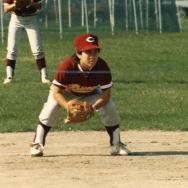On June 23, 1972, Title IX of the Education Amendments was signed into federal law. It stated that, "No person in the United States shall, on the basis of sex, be excluded from participation in, be denied the benefits of, or be subjected to discrimination under any education program or activity receiving Federal financial assistance."
At the collegiate athletics level, Title IX ensures that women and men are provided equitable opportunities to participate in sports. Fifty years after the landmark legislation, we take an overview look at the rise of women's athletics at the University of Chicago.
Early days
Women's athletic activity was a staple in the early years of the institution. Gertrude Dudley became the leader of a movement towards expanding athletic and competitive opportunities for women at UChicago. Dudley was hired as Director of Physical Culture for Women in 1898. She remained in that capacity through 1935 and helped facilitate the growth of women's sports.
Dudley was an undergraduate student at Mount Holyoke, one of the early vanguard schools who established athletic activity for women. She brought her vision and traditions of the eastern schools to UChicago. Dudley's innovations during her tenure were consistently supported throughout the university community and garnered high enthusiasm from the student body. She believed that physical education was essential to the betterment of the student's intellect and comportment.
Dudley moved away from the stylized Swedish and German gymnastics training that was popular at the time and introduced interclass competition. Under her leadership, competitive intramural basketball, field hockey, baseball and tennis quickly became popular women's sports. Dudley started an Annual Field Day for University women, which featured competition in various team and individual sports.
The class games soon became a staple. Students could choose basketball, baseball, field hockey, and swimming, and would compete class against class, with tournaments at the end of the quarter. Offerings expanded to include tennis, gymnastics, rowing, fencing, lawn hockey and golf.
The establishment of the Women's Athletic Association in 1904 helped organize, codify and advance the cause of women's sports in the decades to follow. The WAA seeks to "encourage close relationships between the women athletes of the University of Chicago in order that they may work together as a body to promote women's athletics." As opportunities for women in sports changed and grew, the organization evolved from one that promoted intramural opportunities into the letterwinner's organization for varsity women.
In the 1920s and 1930s, intramural participation continued along with the development of specialty clubs: Tarpon (swimming), 300 Club (bowling), Pegasus (equestrian), Artemis (archery), Racket (tennis) and an Outing Club.
Edith Ballwebber took on the mantle of directing women's athletics at UChicago starting in 1937 and continued in that role through 1967. Women's intercollegiate competition in the 1930s and 1940s was conducted during Play Days. Schools from the Midwest would gather at one site and teams were formed with representatives from different schools. This allowed a higher level of competition without putting too much emphasis on winning. Telegraphic competition was held in swimming and archery; individuals would compete at their home institution, and results were compiled at a neutral site to determine place finishes.
Intramural and club competition continued in the 1950s and 1960s with some very limited intercollegiate competition conducted in basketball, softball, swimming, tennis and volleyball.
Varsity competition (1960s-80s)
In the late 1960s, regular intercollegiate competition began to develop for women under the leadership of Mary Jean Mulvaney and Patricia Kirby.
Mulvaney arrived at UChicago in 1966 as chair of the Department of Physical Education - Women's Division. She served in athletics for 24 years until her retirement in 1990. In 1976, Mulvaney was named chair of a consolidated men's and women's athletic department at UChicago, thus becoming one of the nation's first female athletic directors of a coeducational department.
Mulvaney raised the profile of the department within the University community, while also nurturing the growth of the women's varsity program. The department increased its women's sports offerings from three to nine during her tenure. As a trailblazer and pioneer in athletic administration, Mulvaney was active on the national level as well. She served on committees for the Association of Intercollegiate Athletics for Women, the National Association of Collegiate Directors of Athletics, the Division III Executive Council and the NCAA Council.
In the wake of her retirement, Mulvaney was feted by numerous organizations for her legacy as an athletic administrator. She was an inductee of the UChicago Athletics Hall of Fame and the NACDA Hall of Fame, and received a Lifetime Achievement Award from the National Association of Collegiate Women Athletic Administrators.
One of Mulvaney's key early hires was Patricia Kirby to begin the volleyball, basketball and softball varsity programs. Kirby worked for the University from 1967-90—she coached badminton, basketball, softball and volleyball, while also filling the role of Associate Chair of Physical Education and Athletics. Kirby was part of a historic moment when her basketball squad became the first women's team in the nation to fly to an away game, taking part in a tournament hosted by MIT in 1974. Her impact was recognized with her eventual induction into the UChicago Athletics Hall of Fame.
In 1972, UChicago offered a full-tuition athletic scholarship for women athletes, appropriately named the Gertrude Dudley Scholarship. It was the first nationally advertised athletic scholarship to be offered to women in the country. Parade magazine featured the Dudley Scholarship in its March 18, 1973 issue, which helped drive overwhelming interest. More than 1,000 applications convinced UChicago to offer two scholarships per year. The first two recipients of the Dudley Scholarship were Noel Bairey (swimming) and Laura Silvieus (basketball/softball).
The Association of Intercollegiate Athletics for Women (AIAW) was founded in 1971 to govern collegiate women's athletics and administer national championships. The collegiate sport regulatory organization continued to rise in popularity and influence, with nearly 1,000 member schools at its peak. The UChicago women began competing in the AIAW in 1974. Most notably, the Maroon softball team captured back-to-back AIAW state championships in 1977 and 1978 under Kirby's leadership.
The AIAW eventually folded, and the Maroon varsity women would join the men in NCAA Division III starting in 1982.
The UAA era (1987-present)
During the 1980s, several small to medium-sized research universities began to examine the direction of their athletics programs as well as the relationship of athletics to the whole of their respective institutions. After several years of discussions and development, the University Athletic Association (UAA) was officially formed on June 25, 1986. The launch of full competition occurred in the 1987-88 academic year.
Mulvaney was a critical contributor to the formation of the UAA. Her active involvement inside the association included roles as Secretary and Chair of the Athletic Administrators' Committee, as well as member of the Executive Committee. She ultimately received the UAA Founders Medal, and was recognized for her contributions in 2012 during the conference's silver anniversary celebration.
The eight current members of the UAA include: Brandeis University, Carnegie Mellon University, Case Western Reserve University, Emory University, New York University, University of Rochester, Washington University in St. Louis and UChicago.
Rosalie Resch has played a prominent role in UChicago's modern era as well. She first arrived on the Hyde Park campus in 1969 as a varsity student-athlete, representing the Maroons in volleyball, softball and badminton. Her .481 career batting average in softball is still tied for the school record.
After graduating in 1973, Resch eventually resumed her involvement in collegiate competition at UChicago in the coaching realm. She spent 21 years as the head volleyball coach from 1977-97, and remains the program's all-time leader in victories. She was also head coach of the softball team for one season in 1985.
Now entering her 48th year at UChicago, Resch serves as Senior Associate Athletic Director for Finance and Internal Operations. Her involvement touches all aspects of departmental operations, including overall management of UAA and NCAA regional championships conducted on campus. Resch has also been active on numerous NCAA and UAA committees over the years.
Following in Mulvaney's footsteps, Erin McDermott (2013-20) and Angie Torain (2021-present) have both held the roles of Director of Athletics & Recreation at UChicago.
Since the formative years of the UAA, the Maroons have risen to prominence as one of the top athletic departments in all of NCAA Division III. In the annual LEARFIELD Directors' Cup rankings, UChicago finished in the top 20 for six-straight years (2014-19). The 2021-22 academic year was the school's most successful yet with a seventh-place finish in the Cup standings.
UChicago currently sponsors 20 varsity sports (10 women, 10 men). The women's sports include basketball, cross country, lacrosse, soccer, softball, swimming & diving, tennis, indoor track & field, outdoor track & field and volleyball. Women's lacrosse is the school's newest varsity sport, making its on-field debut in 2019.
Women's athletics have been particularly successful since joining the UAA. In that time period, the 10 sports have accounted for 29 team conference championships, 80 trips to the NCAA postseason and 13 top-four finishes at the NCAA Division III Championships. Soccer leads the way with 20 NCAA tournament selections, while soccer and tennis are tied with five trips to the NCAA semifinals.
Dating back to 1999, Maroon women have claimed 15 NCAA Division III championships in individual competition and five national player of the year selections in their respective sports. Rhaina Echols (Class of 2000) leads the way with four national titles between cross country, indoor track & field and outdoor track & field. Isabel Maletich (Class of 2022) won three NCAA championships in the horizontal jumps between indoor and outdoor track & field.
—This story was first published by UChicago Athletics. See the full list of the University of Chicago's Division III champions and National Players of the Year.

